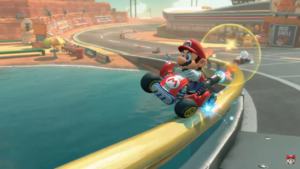When Nintendo first dropped Super Mario Party Jamboree on the original Switch back in October 2024, it felt like a fresh spin on a familiar formula. The beloved characters, the zany mini-games, the frenzied board-game antics—everything was there, but it still somehow managed to surprise. Fast-forward three months, and Nintendo has officially confirmed what many of us suspected: the Switch 2 is coming, and it’s going to breathe new life into some of our favorite titles. Super Mario Party Jamboree is one of the first to get the next-gen treatment, and Nintendo’s latest promo video gives us a tantalizing glimpse at the upgrades, tweaks, and entirely new ways to play.
In this deep dive, we’ll walk you through everything Nintendo has revealed—plus a few educated guesses—about Super Mario Party Jamboree for Switch 2. From innovative control schemes and voice commands to a brand-new “Jamboree TV” mode that literally puts you on screen, there’s a lot to unpack. By the end, you’ll know not just what’s coming, but why these changes feel like more than simple window dressing. Let’s get into it.
A Fresh Coat of Paint: Visual and Performance Upgrades
One of the first things you’ll notice about Super Mario Party Jamboree on Switch 2 is how crisp everything looks. Nintendo is finally taking full advantage of WQHD (1440p) resolution when the console is docked, and that jump is immediately apparent. Whether you’re zooming through Bowser’s fiery fortress or admiring the pastel-hued balloons floating over Carnival Coaster, the extra pixels make each scene pop. Handheld mode also receives an upgrade to 1080p, so even when you’re away from the big screen, the graphics stay sharp and vibrant.
Under the hood, frame rates have been smoothed out too. On the original Switch, some of the more chaotic mini-games—think Crazy Cacti Canyon or Mech Mario Mayhem—could dip below 30 FPS during the most hectic moments. On Switch 2, Nintendo promises a rock-solid 60 FPS across the board, meaning animations play out buttery-smooth and inputs register without any perceptible lag. For a party game that lives and dies by split-second reactions, that performance bump is more than cosmetic; it fundamentally changes how you experience the action.
Rethinking Controls: Joy-Con 2 Mouse Mode & Beyond
One of the head-turning revelations in Nintendo Japan’s four-minute feature overview is the introduction of alternate control schemes—built specifically for Switch 2’s new hardware. Chief among these is the Joy-Con 2’s mouse mode. Picture this: instead of tilting your controller or tapping buttons in quick succession, you’re pointing directly at the screen, clicking, dragging, and flicking your way through challenges.
It’s an idea that sounds simple on paper, but in practice, it opens up a world of possibilities. In mini-games like Toad’s Treasure Tote, where you scoop gems into a cart, mouse mode allows for a level of precision that was previously impossible. Imagine guiding your cursor around obstacles with pixel-perfect accuracy, or snatching power-ups from under an opponent’s nose with a deft flick of your wrist. Even classic board-game sections could see new interactions—tapping to roll dice, dragging to reposition characters, or sketching a path for a drifting balloon.
The Switch 2 Camera also plays a role here. Using on-board sensors, the console can track your hand movements when you hold the Joy-Con 2 like a pointer, translating real-world gestures into on-screen actions. It’s a melding of physical and digital play that nods back to the days of the Wii Remote, yet feels entirely new thanks to modern sensors and processing power.
Speak Up! Voice Commands Take Center Stage
Voice commands in a party game might sound gimmicky, but Nintendo is serious about integrating them meaningfully. The promo video teases situational voice controls—activated, for example, during the fan-favorite Carnival Coaster event. Instead of jamming buttons to build up speed, you might shout “Go!” or “Faster!” to rev your character’s cart. During Bowser Live segments, barking orders like “Attack!” or “Defend!” could trigger special moves, giving you hands-free control when you’d rather focus on strategy.
Of course, this isn’t going to replace traditional inputs entirely. If you’re in a crowded living room where shouting commands would feel awkward, you can stick to buttons or the new mouse mode. But for those moments when you want to lean into the showmanship of Mario Party—when you’re hosting a multiplayer marathon or streaming to an audience—voice commands add a theatrical flair that’s hard to replicate any other way.
Be the Star: Jamboree TV Mode
Perhaps the most ambitious new feature is Jamboree TV mode, which leverages the Switch 2 Camera to insert live video of players into the game itself. Imagine rolling onto the screen behind Mario as a shadowy silhouette, or appearing next to Princess Peach as she critiques your dice rolls. The promo suggests game-show–style activities, complete with virtual host announcements and on-screen graphics that highlight player cams in real time.
It’s a mash-up of classic game-show tropes and modern streaming culture. If you’ve ever watched a “Let’s Play” video and thought, “Wouldn’t it be cool if viewers could see me reacting right in the game?”—this is Nintendo’s answer. You’ll be able to position your video feed in different layouts, toggle overlays that display scores or star counts, and even apply digital props (think silly hats or moustaches) via on-console filters.
Whether Jamboree TV catches on will depend on how easy Nintendo makes it to share clips and streams. If they can offer direct integration with streaming services or simple one-touch recording features, Jamboree TV could become a must-have for content creators. But even for casual players, being able to see yourself bumble through the Cheep Cheep Challenge or leap over lava pits adds a novel layer of immersion.
Multiplayer Made Easy: GameShare and Beyond
Local multiplayer has always been at the heart of Mario Party, but long download times and the need for multiple copies of the game have occasionally been hurdles. Switch 2 Edition solves this with expanded GameShare support: up to four players can join in using a single cartridge—or a single digital purchase. Each player’s Switch 2 downloads a lightweight client version that syncs wirelessly to the host system, meaning you can invite friends over and jump straight into the fun without anyone having to install the full game.
Online play has also been spruced up. Nintendo is touting improved netcode that aims to reduce lag during cross-country matches, and there’s talk of new online-exclusive mini-games designed around smaller group sizes. Competitive leaderboards, daily challenges, and themed events (like Mushroom Kingdom Marathon weekends) round out the online offering, ensuring there’s always something new to try even after you’ve beaten every board and unlocked every trophy.
Two New Commercials, One Big Tease
To drum up excitement, Nintendo Japan released two new commercials alongside the feature video. The ads blend live-action footage of families and friends playing with in-game footage, underscoring the new control schemes and Jamboree TV mode. One spot highlights four kids crowded around a kitchen table, each shouting commands and waving their Joy-Con 2 controllers as confetti explodes on screen. The other takes a more cinematic tack: a group of college students in a dorm lounge all pointing at the TV like game-show contestants, with quick cuts to the mouse mode pointer zipping across the board.
Both commercials nod to the same message: Super Mario Party Jamboree for Switch 2 isn’t just a port—it’s a reimagining. By weaving together live-action and gameplay scenes, Nintendo is selling an experience that bridges the gap between the physical and digital, the personal and the performative.
When Can You Get Your Hands on It?
Mark your calendars for July 24, 2025—the Switch 2 Edition + Jamboree TV drops just over seven weeks after the console’s launch. That timing is no accident. Nintendo clearly wants to use a marquee party title to showcase Switch 2’s new features from day one. The full title—Super Mario Party Jamboree – Nintendo Switch 2 Edition + Jamboree TV—may be a mouthful, but it sets expectations: this is the definitive version for the next-gen hardware.
It’s also worth noting that at least 11 other Switch 1 games will receive paid upgrades in the coming months, while a similar number will get free enhancements. Nintendo’s tiered approach means you can pick and choose which of your library favorites are worth rebuying. But for fans of Mario Party, upgrading to the Switch 2 Edition of Jamboree will feel less like an optional purchase and more like a necessary one if you want the full experience.
Why These Changes Matter
At first glance, some of these additions—voice commands, camera integration, mouse mode—might seem like optional bells and whistles. But taken together, they paint a picture of Nintendo’s broader strategy for Switch 2: to blur the lines between console gaming, live streaming, and social play.
- Accessibility and Precision: Mouse mode and improved frame rates make games more accessible to new players and give veteran gamers the precision they crave.
- Immersive Interaction: Voice commands and Jamboree TV break down the fourth wall, turning Mario Party from something you watch to something you inhabit.
- Seamless Social Play: Expanded GameShare and better online features ensure that getting into a game is as painless as sending an invite link.
In short, Switch 2 Edition isn’t just about prettier graphics; it’s about rethinking how we connect, compete, and celebrate in a party game context. And if Super Mario Party Jamboree is any indication, Nintendo is focused on making the next generation of social gaming more dynamic, more immersive, and more inclusive than ever before.
Looking Ahead
While Super Mario Party Jamboree will be one of the first titles to showcase Switch 2’s new capabilities, it certainly won’t be the last. With Mario Kart World also confirmed to feature Switch 2 Camera integration, it’s clear that Nintendo intends to weave these hardware features across its biggest franchises. As developers grow more comfortable with Joy-Con 2’s mouse mode and the console’s microphone and camera, we can expect increasingly creative uses in genres beyond party games—think first-person adventures, strategy titles, and maybe even the next iteration of fitness games.
For now, though, Mario Party fans have plenty to look forward to. Whether you’re a casual player who loves the chaos of family game night or a streamer searching for the next big interactive format, Super Mario Party Jamboree on Switch 2 promises to deliver an experience that’s familiar yet thrillingly new. July 24 can’t come soon enough.
As of October 2023, Nintendo has announced that Super Mario Party Jamboree will also feature a new “Dynamic Weather” system, where in-game weather conditions will change based on real-world data. This feature aims to add an extra layer of unpredictability and excitement to the gameplay, as players might find themselves navigating through a sunny board one moment and a stormy challenge the next.
Additionally, Nintendo is planning to introduce a “Community Creations” hub, allowing players to design and share their own mini-games and board layouts. This user-generated content could significantly extend the game’s lifespan and foster a creative community around Super Mario Party Jamboree.


 Unreal 5
Unreal 5


It’s exciting to see how Nintendo is evolving the Mario Party experience with the Switch 2. The new features like enhanced graphics, innovative control schemes, and the immersive Jamboree TV mode make it sound like a fresh and engaging way to enjoy the beloved party game. Can’t wait to see how these changes enhance the fun and social aspects of the game!